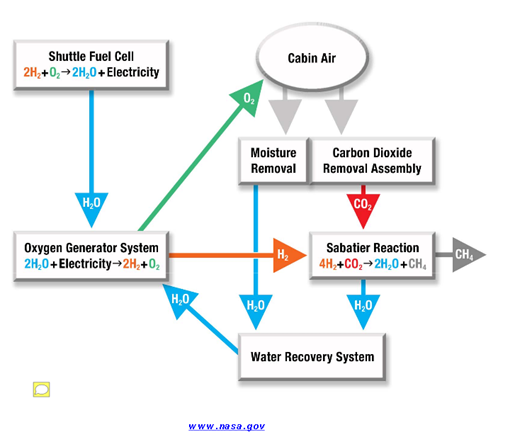The ISS must reclaim oxygen and water in order to sustain human life over the course of a long period of time, as it is cost inefficient to fully stock on these provisions. Closing the loop, as NASA life support engineers call it, is the solution for removing waste products, recycling, and reintroducing them.

Air
Space shuttles produce electricity and water by using fuel cells to combine oxygen and hydrogen. The water is then used in an oxygen generator to produce breathable air. The ISS however, doesn't have fuel cells and must rely on the Russian Progress resupply ship to ferry water. The oxygen cargo is then deposited from the cryogenic tank of the shuttle to be use by the crew of the ISS.
In a short time, an oxygen generator system will be installed aboard the ISS and will use a process called electrolysis, the reverse process of fuel cell reaction, to combine water with electricity and reclaim oxygen and hydrogen. However, hydrogen is highly violated and must vent out into space in order to avoid a catastrophe.
Carbon Dioxide removal
The carbon dioxide aboard the ISS is removed using the Carbon Dioxide Removal System (CDRA). A process called carbon dioxide scrubbing takes place, in which CO2 is blown through a bed of synthetic rocks called zeolite, which draws all the CO2 and water vapor leaving behind everything else. Using plants for the removal of CO2 and production of Oxygen is considered impractical because they take up too much space, mass, water, soil, nutrient, and power for lamps.
Water
As a solution for ISS's water production capabilities, NASA life support engineers are developing a water recycling system that takes advantage of the Sabatier Reaction , the process reclaiming water from the combination of CO2 and hydrogen . This eventuality will free up space aboard the ISS to store other equipment, rather than water.
Ensuring the water storage is drinkable requires a combination of methods: physical and chemical to removes contaminants, filtration, and temperature sterilization. The crew must regularly inspect the water to verify that if fulfills NASA's water quality requirements.
Article provided by NASA.gov. For more information, download the research paper below.
By Maximilian Teodorescu
Advertisement





